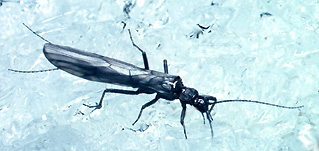

Capnia gracilaria from Colorado.
===================== Bolshecapnia
|
| =============== Capnia spinulosa
|=====|
| =============== Bolshecapnia maculata
|
===| =============== Capnia californica group
| | |
| | | ============ Capnia mariposa group
| ======| |
| ===| ========= Capnia barberi group
| ===|
| ========= Capnia decepta group
|
| ========= Capnia nigra TYPE
| ======|
| | ========= Capnura
| |
| | ====== Capnia vidua
| | ===|
| ======|=====| ====== Allocapnia
=====| | | |
| | | ========= Capnia nearctica group
| | |
| | |============== Utacapnia
| | |
| | =============== Capnia sextuberculata
| |
===|==================== Capnia coloradensis group
|
| ============ Capnia gracilaria group
| |
| | === Capnia excavata group
| | ===|
| |=====| === Capnia nana group
| ===| |
======| | ====== Capnia vernalis group
| |
| | ====== Mesocapnia
| ======|
| ====== Capnia zukeli
|
=============== Capnia scobina
Unpublished tree from matrix in "capnia data 16 Oct 1991" by C. R. Nelson.
Another way of viewing the classification of Capnia is to lump the genera, of known affinities, above (toward the more derived terminals) Eucapnopsis on the tree shown on the Capniidae page into a single very large genus. In this sort of treatment genera such as Allocapnia, Capnura, and Utacapnia are treated at or near subgeneric rank. This large genus would necessarily be called Capnia because it contains the type, Capnia nigra. The lack of a sternal vesicle on the abdomen serves as a synapomorphy for Capnia sensu lato, with a few exceptional reversals.
The phylogenetic status of Bolshecapnia is critical to this view of a very large genus Capnia. I doubt the monophyly of Bolshecapnia. I've seen many illustrations of Palearctic forms that might be closely related to it, but I think only a portion of these species will be the sister to Capnia sensu lato. Of course an even more expanded concept of Capnia could include Bolshecapnia and all its related forms. In this latter concept the characters defining Capnia would be those which separate it from Isocapnia and Eucapnopsis (among others): a curving origin to R1 in the wing beyond the radial sector.



 Go to quick links
Go to quick search
Go to navigation for this section of the ToL site
Go to detailed links for the ToL site
Go to quick links
Go to quick search
Go to navigation for this section of the ToL site
Go to detailed links for the ToL site